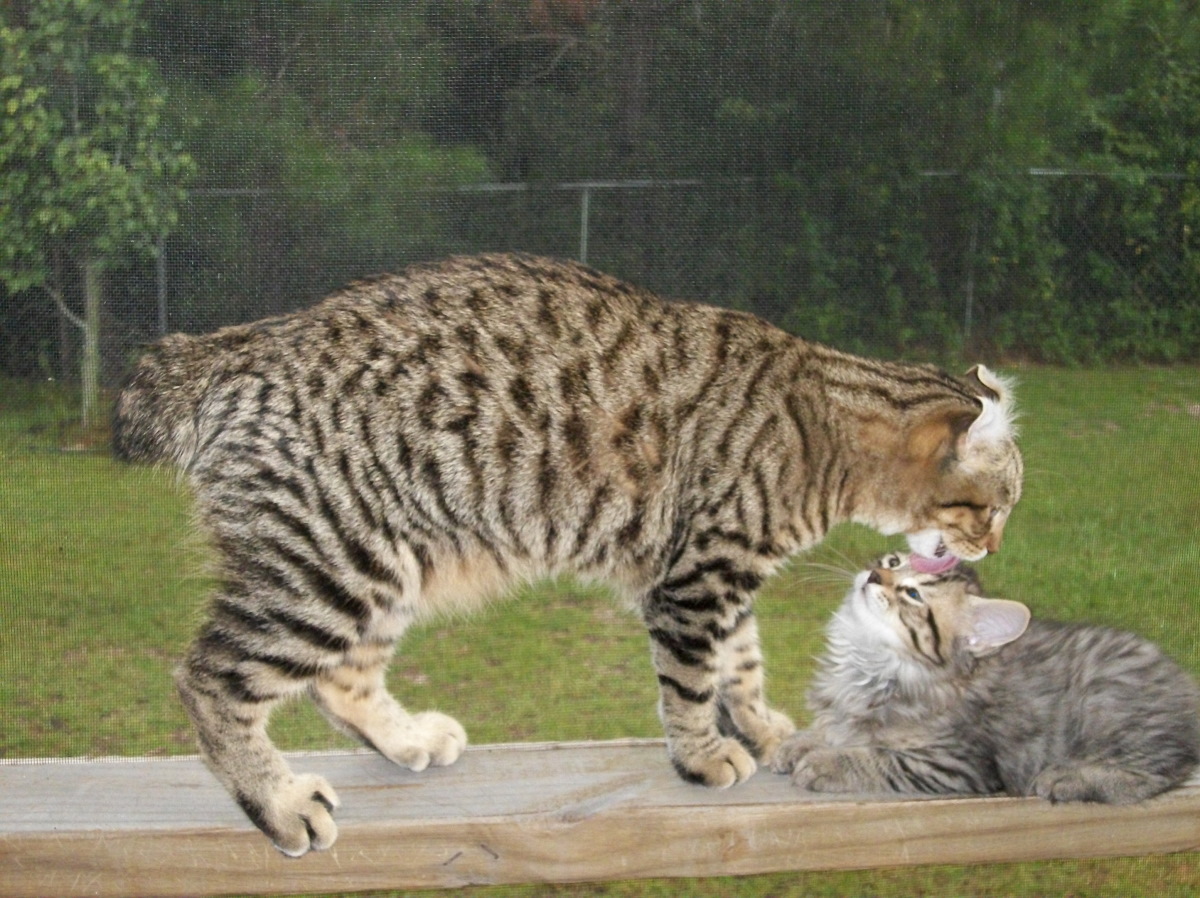
Highland Lynx, Desert Lynx, and Mohave Bobs are part of the Desert Lynx breed group in the Rare & Exotic Feline Registry. However, such crosses should be carefully chosen to complement the overall type of the Highland Lynx cat. Out-crosses to either unregistered or purebred cats are permitted. Contrast should be good, with distinct shapes and sharp edges. The pattern gives the impression of marble, preferably with a horizontal flow. The clouded leopard pattern, while derived from modifications to the classic tabby gene, is different from the classic tabby pattern, with as little bull's eye similarities possible. Necklace tracings will are also frequently seen. The tail, legs, and face will have tabby penciling. The body may exhibit a barely perceptible spotted pattern. In the sepia, mink, and snow subdivisions, it is desirable for ghost leopard spots to appear on the bodies. The tawny pattern is a ticked tabby pattern marked by ticking on the body hair with various shades of the marking color and ground color, with the outer tipping being the darkest and the undercoat being the ground color. The markings on the face and forehead are typical tabby markings, with the underside of the body having distinct spots. A dorsal stripe runs the length of the body to the tip of the tail. Contrast with ground color may not be as distinct as the silvers. The spots may vary in size and shape, but should be evenly distributed. It is marked by spots of the darker color, most prominent on the sides of the body and the belly. The leopard pattern is a spotted tabby pattern. Solid colored cats, as well as mackerel tabby, do sometimes occur. The coat patterns are tawny (ticked), leopard (spotted), and clouded (marble). Highland Lynx officially come in three coat patterns in all eumelanistic and melanistic colors-ebony, blue, sorrel, fawn, chocolate, lilac, red, and cream -including silver, cameo, sepia, mink, and snow. The tail may come half way to the ground, or it may be lacking entirely, as in the Manx, or it may be any length in between. The wide set eyes are large and expressive, set at an angle, with colors ranging from gold to green, with blue eyes in the snows. The head is large but not round, with a full, well-developed muzzle that is almost square in appearance, with prominent whisker pads. These cats come in both long and short hair. Cats with regular feet will never throw polydactyl kittens. The males are larger than females and slower to mature. When two polydactyl cats are bred together, some of the kittens will be polydactyl and some will have regular feet. Some cats are polydactyl while others are not. The polydactyl gene (which produces extra toes) is a dominant gene which is considered a desirable trait in these cats. These cats are strong, muscular cats which are medium in length with longer hind legs, and toes may be tufted. The gene which causes the ear to curl actually hardens the cartilage in the ear and dwarfs the ear size. Ears curl backwards at the tips. The degree of the curl may be slight or extreme, with the tip of the ear actually curling back and touching the back side of the ear. The Highland Lynx have small curled ears that are set wide apart, usually with feathering and tufts on the tip. When the two breeds are bred together, the straight-eared kittens resulting from the breeding do not carry genes for curled ears. The curled ears of the Highland Lynx are caused by a dominate gene which both curls the ears and somewhat reduces the size of the ears. Kittens with straight ears may be registered as Desert Lynx while the kittens with curled ears may be registered as Highland Lynx. The Rare & Exotic Feline Registry considers the two breeds to be of the same breed group and are born in the same litter. Desert Lynx and Highland Lynx are essentially the same cats with different ears.

The Desert Lynx most likely derived from the breeding of a two of the following: Maine Coon, American Bobtail, Pixie-Bob or Manx. Timberline Cattery pioneered the development of the Highland Lynx by crossing Desert Lynx cats with Jungle Curls. The Jungle Curl cat is a curled eared wild cat hybrid - a cross betwee n the African Jungle cat and the Hemingway Curl. Highland Lynx is the only cat breed specifically developed from two existing breeds. The very first Highland Lynx litter was born on Jat Timberline Cattery. The first generations of wild cat have long since been breed out. The Highland Lynx is now purely a domestic cat.


 0 kommentar(er)
0 kommentar(er)
